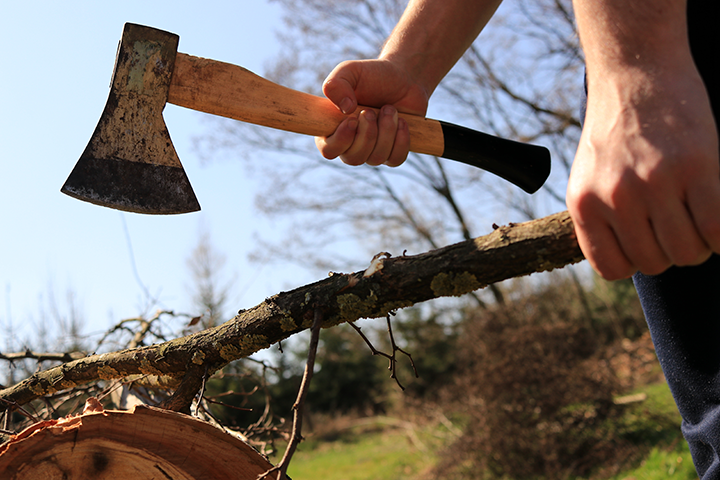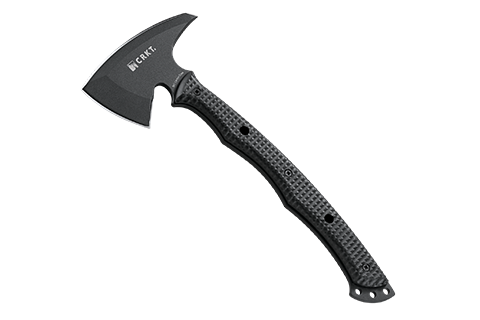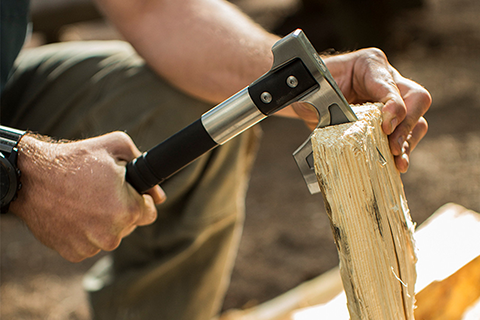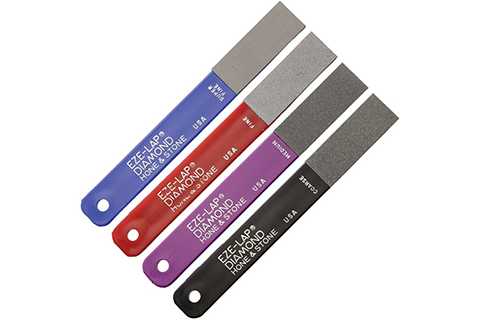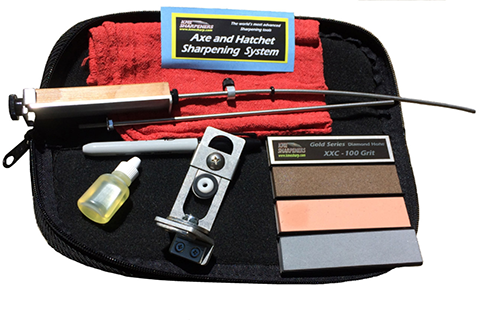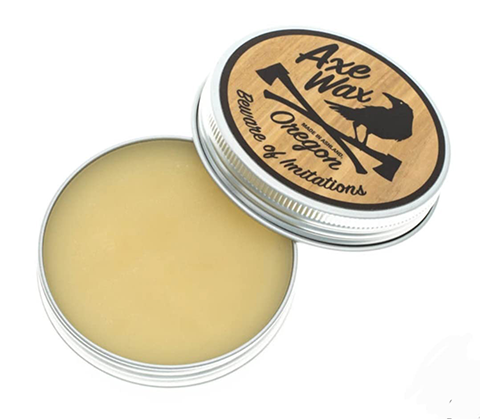Blog #11 - Camp Axes: Uses and Maintenance
Author: Knife Supplies Australia Date Posted:3 November 2023
When you’re out in the bush, having the right tools makes all the difference. Camp axes, commonly referred to as hatchets, are a versatile and indispensable tool for anyone who loves spending time in the bush. In this Knife Supplies Australia blog, we'll cover everything you need to know about camp axes and their accessories, from their uses and materials to maintenance and sharpening.
What Are Camp Axes?
Camp axes, or hatchets, are compact and lightweight cutting tools designed for outdoor use. They are characterized by their short handles and sharp blades, making them ideal for a variety of tasks in camping, hiking, and survival situations. These versatile tools have been a staple in outdoor enthusiasts' kits for generations due to their efficiency and utility.
A popular camp axe is the CRKT Kangee T-Hawk Tomahawk:
Uses of Camp Axes
1. Splitting Firewood
One of the primary tasks for camp axes is splitting firewood. The sharp edge of a camp axe can effectively split logs into smaller pieces, making it easier to start and maintain a campfire. Whether you're cooking, keeping warm, or simply enjoying the ambiance of a crackling fire, a camp axe is an essential tool.
2. Shelter Building
When out in the bush, shelter is crucial for survival. Camp axes are invaluable for chopping branches and logs to construct a sturdy shelter, such as lean-tos or simple A-frame structures. Their compact size allows for precise cuts, making them ideal for crafting shelter components. Shelter building can be a fun activity, but it could also save your life in an emergency.
3. Food Preparation
Camp axes can also be used for food preparation tasks, such as chopping vegetables, meat, or even filleting fish. Their portability makes them a convenient option for cooking in the great outdoors.
A great example of a compact camp axe suitable for food preparation is the CRKT Jenny Wren Compact Tomahawk:
4. Clearing Tracks
When bushwalking or camping in remote areas, you may come across overgrown tracks or obstacles that need clearing. Camp axes can help remove debris and clear a path.
Common Materials of Camp Axes
Camp axes come in a variety of materials, each with its advantages and considerations:
1. Carbon Steel
Steel camp axes are known for their durability and sharpness. High-carbon steel is a popular choice because it retains its edge well, making it suitable for heavy-duty tasks. The main downside to carbon steel is that it easily rusts. With attention to maintenance this can be avoided, but it does take more time and effort than stainless steel. Most traditional axes are carbon steel.
2. Stainless Steel
Stainless steel camp axes are resistant to corrosion, making them ideal for wet and humid environments. They require less maintenance but may not hold an edge as long as high-carbon steel.
3. Fiberglass Handle
Some camp axes feature fiberglass handles, which are lightweight and resistant to weather conditions. They provide excellent grip and are less prone to splintering.
The SOG Camp Axe is a robust fiberglass-handled camp axe:
4. Wooden Handle
Traditionalists often prefer camp axes with wooden handles for their aesthetics and comfort. However, wooden handles may require more maintenance and can be prone to cracking if not cared for properly.
Accessories for Camp Axes
To enhance the functionality of your camp axe, consider these essential accessories:
1. Sheath or Cover
A sheath or cover is essential for protecting the axe blade and preventing accidents when not in use. It also makes carrying the axe safer. This is important because axes are one of the most dangerous tools you can use and carry in the bush if used or stored improperly.
2. Handheld Sharpening Stones
Maintaining a sharp blade is crucial for camp axes. Sharpening stones, available in various grits, allow you to keep your axe blade in optimal condition.
The Eze-Lap Diamond Handheld Sharpener Set is a great way to sharpen axes, and provides a range of 240, 400, 600, and 1200 grits:
3. Axe Wedges
Axe wedges are used to secure the axe head to the handle. Over time, the axe head may become loose, and these wedges can help maintain a tight connection. Do not use an axe that has a loose head as they have a very high risk of injury.
4. Axe Belt
An axe belt or holder provides a convenient way to carry your camp axe while hiking or camping. It allows quick access to the tool when needed.
How to Sharpen a Camp Axe
Sharpening a camp axe is a skill every outdoor enthusiast should master. Here's a step-by-step guide to keeping your axe blade sharp:
- Gather Your Materials: You'll need a sharpening stone or file, lubricating oil, and a honing guide (optional).
- Secure the Axe: Place the camp axe securely in a vise or against a stable surface, ensuring it won't move during sharpening.
- Identify the Bevel Angle: Determine the angle of the bevel on your axe blade. This angle varies depending on the manufacturer and type of axe.
- Apply Lubricating Oil: To prevent overheating and prolong the life of your sharpening stone, apply a few drops of lubricating oil to the stone's surface.
- Sharpen the Blade: Maintain a consistent angle as you pass the sharpening stone over the blade. Use long, sweeping strokes and work evenly on both sides of the blade. Repeat this process until you achieve a sharp edge.
- Hone the Edge: For a finer edge, use a finer-grit stone or a honing guide. This step helps refine the blade and make it razor-sharp.
- Test the Sharpness: Carefully and gently scrape your finger against the blade's edge to check for sharpness. Be cautious to avoid cutting yourself.
- Clean the Axe: Wipe off any residue from the sharpening process and apply a light coat of oil to prevent rust.
Take the complexity out of Axe Sharpening with the made-in-USA KME Axe Controlled Guided Sharpening System:
How to Maintain a Camp Axe
Proper maintenance is crucial for preserving your camp axe's longevity. Here's how to keep your axe in top condition:
- Keep It Clean: After each use, clean your camp axe to remove dirt, sap, and moisture. Dry it thoroughly to prevent rust.
- Oil the Handle: If your axe has a wooden handle, regularly apply linseed oil to keep it conditioned and prevent cracking.
- Inspect for Damage: Periodically check the axe head for signs of damage or looseness. Replace or repair any damaged parts promptly.
- Store Properly: Store your camp axe in a dry, cool place, preferably in a sheath or cover to protect the blade.
- Regularly Sharpen: Maintain a sharp edge by sharpening your axe as needed, as discussed earlier in this guide.
Discover the secret to beautifully finished knife and axe handles, rust-free blades, and water-resistant leather with Axe Wax – the premium, 100% all-natural and food-safe wood finish and corrosion inhibitor. This true hardening wax formula is expertly handmade in the U.S.A., in Ashland, Oregon:
In conclusion, camp axes, or hatchets, are indispensable tools for outdoor enthusiasts, serving various purposes such as splitting firewood, building shelters, food preparation, and clearing tracks. They come in different materials, each with its advantages, and can be enhanced with accessories like sheaths, sharpening stones, wedges, and belts. Proper maintenance and sharpening are essential to keep your camp axe in optimal condition, ensuring it remains a reliable companion on your outdoor adventures. So, whether you're an experienced camper or a new to roughing it in the outdoors, make sure to include a camp axe in your outdoor toolkit for a safer and more enjoyable outdoor experience.


